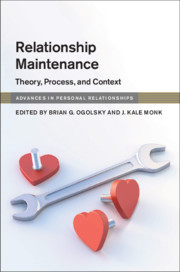Book contents
- Relationship Maintenance
- Advances in Personal Relationships
- Relationship Maintenance
- Copyright page
- Contents
- Tables
- Figures
- Contributors
- Part I Introduction
- Part II Theories of Relationship Maintenance
- Part III Processes of Relationship Maintenance
- 7 Communication and Relationship Maintenance
- 8 Attributions, Forgiveness, and Gratitude as Relationship Maintenance Processes
- 9 Social Networks and Relationship Maintenance
- 10 Dyadic Coping as Relationship Maintenance
- 11 Conflict Management and Problem Solving as Relationship Maintenance
- 12 Sex as Relationship Maintenance
- 13 Accuracy and Bias in Relationship Maintenance
- Part IV The Social Context of Relationship Maintenance
- Part V Conclusion
- Index
- References
8 - Attributions, Forgiveness, and Gratitude as Relationship Maintenance Processes
from Part III - Processes of Relationship Maintenance
Published online by Cambridge University Press: 02 December 2019
- Relationship Maintenance
- Advances in Personal Relationships
- Relationship Maintenance
- Copyright page
- Contents
- Tables
- Figures
- Contributors
- Part I Introduction
- Part II Theories of Relationship Maintenance
- Part III Processes of Relationship Maintenance
- 7 Communication and Relationship Maintenance
- 8 Attributions, Forgiveness, and Gratitude as Relationship Maintenance Processes
- 9 Social Networks and Relationship Maintenance
- 10 Dyadic Coping as Relationship Maintenance
- 11 Conflict Management and Problem Solving as Relationship Maintenance
- 12 Sex as Relationship Maintenance
- 13 Accuracy and Bias in Relationship Maintenance
- Part IV The Social Context of Relationship Maintenance
- Part V Conclusion
- Index
- References
Summary
This chapter details and evaluates existing research on the extent to which three related cognitive processes are associated with the successful maintenance of relationships and relationship satisfaction: benevolent attributions, forgiveness, and gratitude. As detailed throughout the chapter, it appears that the extent to which each process is associated with the successful maintenance of relationship satisfaction depends critically on the context in which it operates, including aspects of the people involved in the relationship, aspects of the relationship itself, and aspects of the environment in which the relationship is embedded. Although each process is associated with the successful maintenance of relationship satisfaction in some contexts, each process is also associated with various personal and interpersonal costs to the extent that it operates in other contexts. Accordingly, we argue that maximizing the benefits of any cognitive relationship maintenance strategy requires a nuanced approach to its investigation.
Keywords
- Type
- Chapter
- Information
- Relationship MaintenanceTheory, Process, and Context, pp. 134 - 151Publisher: Cambridge University PressPrint publication year: 2019



